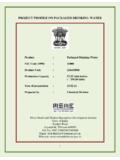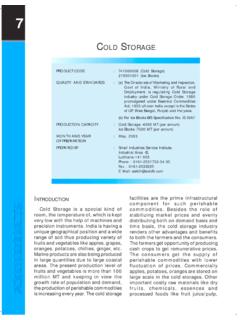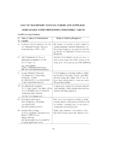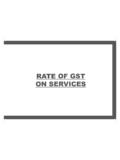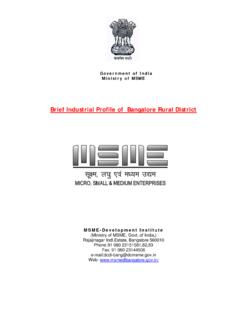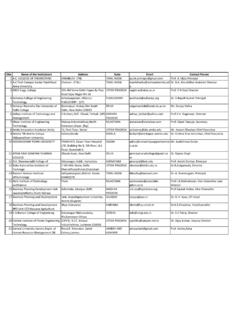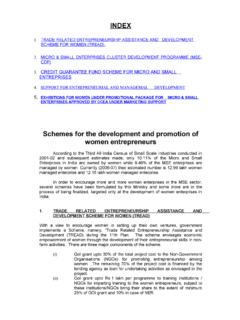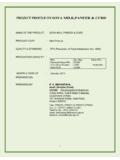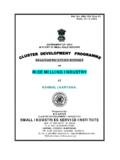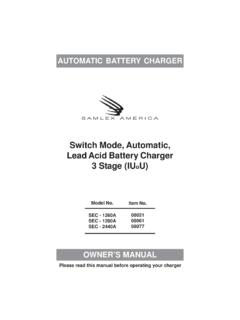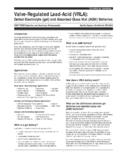Transcription of PROJECT PROFILE ON LEAD ACID STORAGE BATTERIES
1 PROJECT PROFILE ON LEAD acid STORAGE . BATTERIES . 1. Product:- LEAD acid STORAGE BATTERIES . 2. NIC Code(1998):- 362101000. 3. Product Code (ASICC-2000):- - 4. Production Capacity:- QUANTITY : 7,500 Nos. Per Annum VALUE : ,66,10,000/- 5. Month & year of Preparation :- November, 2010. 6. Prepared by:- MSME - Development Institute, Govt. of India Ministry of MSME, 107, Industrial Estate, Kalpi Road, Kanpur-208012. Tele. 2295070, 2295071 & 2295073. Tele. No. 2295072 (SENET & TRC). Tele/Fax No.: 0512- 2240143. E-mail: Website: 0. 1. INTRODUCTION: Lead acid STORAGE BATTERIES is an electro-chemical system that converts electrical energy into direct current electricity. It is also known as STORAGE BATTERIES and has wide applications in Automobiles, UPS/Inverters, Traction/Electrical Sub-Station, Telecommunication, Solar Photovoltaic system etc. 2. MARKET POTENTIAL: Lead acid STORAGE BATTERIES have many applications as stated above and automobile sector consumes the bulk of lead acid BATTERIES .
2 The recent growth in the automobile sector has given tremendous boost to the demand of lead acid BATTERIES . The market size is approximately Rs. 1,300. crores and is growing @ 18 20%. The major automobile BATTERIES manufacturing units are Exide, Amar Raja, Standard Furuka, etc. There are many registered small scale units engaged in manufacturing of these BATTERIES like Sahni BATTERIES , Premier BATTERIES , Gupta BATTERIES etc. Besides this, a no. of units in the unorganized sector are also engaged in manufacturing as well as reconditioning of scrapped BATTERIES . 3. BASIS & PRESUMPTIONS: i) The cost of machinery and equipment is of particular make and prices are approximate. ii) All the operations involved in manufacturing of BATTERIES packs will be done in industrial workshop of the unit. iii) This PROJECT report is prepared on the basis of single shift basis of 8 hrs of working in a day. Total working days in a year come about 300 nos.
3 Assuming 75% efficiency. iv) The skilled and semi-skilled workers in the line are available in the local area. v) The rental value of the land and built-up area has been stipulated on the basis of rate prevailing in the industrial area. It may vary from place to place. vi) Rate of interest has been calculated However, this figure is likely to vary depending on the financial outlay of the PROJECT and location of the unit. vii) The provisions made in other respects viz; personnel, utilities, raw material and overhead etc. are based on the prevailing market rates. viii) All the machinery, raw material would be available from the indigenous sources. ix) The break-even point in this PROJECT has been calculated on envisaged capacity utilisation basis. x) The operative period of this PROJECT is estimated to be about 10 years considering technology obsolescence. xi) Cost of imported items (both raw material and machinery) is inclusive of all taxes/duties and is likely to vary as per the international market prices.
4 Xii) The proposed PROJECT has been considered for UPS of 500 VA, 15. minutes of backup time. However, cost of production of other sizes of UPS may be calculated on similar lines, based on design and components required for the manufacturing the required size of UPS. The basic philosophy remain same for all sizes of UPS. 4. Implementation Schedule: The major activities in the implementation of the PROJECT has been listed and the average time for implementation of the PROJECT is estimated at 12. months: Period (in months). 1. Preparation of PROJECT report 1. 2. Registration and other formalities 1. 3. Sanction of loan by financial institutions 3. 4. Plant & Machinery a) Placement of orders 1. b) Procurement 2. c) Power connection/Electrification 2. d) Installation/Errection of Machinery/Test 2. Equipment 5. Procurement of raw materials 2. 6. Recruitment of Technical Personnel etc. 2. 7. Trial Production 11. 8. Commercial production 12.
5 Note: 1. Many of the above activities shall be initiated concurrently. 2. Procurement of raw materials commences from the 8th month onwards. 3. When imported plant and machinery are required, the implementation period of PROJECT may vary from 12 months to 15 months. 5. TECHNICAL ASPECTS: I. PROCESS OF MANUFACTURE: The manufacturing process consists of stacking of positives and negative plates in the container alongwith PVC separator sheet in between the plates and connecting the plates in parallel and cells in series by soldering. The battery plates are initially procured from outside and manufacturing of these plates may be undertaken in-house subsequently. After connecting the plates, positive and negative leads are brought out and terminals formed by pouring molten lead alloy metal on the top cover of the plates with the help of positives and negative die. The top cover is then sealed with bitumen and testing as per the IS Specification:7372- 1995 is performed.
6 The procedure is applicable to all sizes of the BATTERIES and charging of BATTERIES may be done as per requirement. Process Flow Chart: - 1. Purchased 2. Inspection of 3. Sub-assembly 4. Checking of Components Components finished Products 6. Packing 5. Testing II. QUALITY CONTROL & STANDARD: As per IS Specification IS:7372-1995. III. PRODUCTION CAPACITY (Per Annum): Quantity : 7,500 Nos. Per Annum Value : Rs. 2,66,10,000/- IV. MOTIVE POWER REQUIRED: Power connection of 5 KW is sufficient to run this PROJECT . V. Pollution Control Requirements: The Government accords utmost importance to controlling environmental pollution. The small scale entrepreneurs should have an environmental friendly attitude and adopt pollution abatement measures by process modification and technology substitution. Awareness among the staff members of the industrial undertaking should also be created for abatement of pollution. India having acceded to the Montreal Protocol of 1992, it has become mandatory for India to phase out the production and use of Ozone Depleting Substances (ODS) like Chlorofluoro Carbon (CFCs), Carbon Tetrachloride, Halons and Methyl Chloroform etc.
7 These chemicals/solvents are to be phased out immediately with alternative chemicals/solvents. From phase out angle, we may have ten years to go, but from commercial angle immediate phase out is of utmost importance. VI. Energy Conservation: With the escalating demand for energy to sustain the pace of economic development of our country, energy conservation is not only desirable but absolutely imperative. Every user of energy is a potential saver of energy. It is profitable and obligatory upon every user to use energy efficiency. The following steps may help in conservation of electrical energy: (i) Adoption of energy conserving technologies, production aids and testing facilities. (ii) Efficient management of process/manufacturing machineries and systems, QC and testing equipments for yielding maximum energy conservation. (iii) Optimum use of electrical energy for heating during soldering process can be obtained by using efficient temperature controlled soldering and desoldering stations.
8 (iv) Periodical maintenance of motors, compressors and other power driven equipments, lubrication of motors and motor drives regularly;. use of power factor correction capacitors across the motor terminals and tightening of the belt and pulley at regular intervals should be done to improve the efficiency of the system. Also, the motors should have good quality insulation to minimize the leakage currents and sparks. Lighting: (a) Proper selection and layout of lighting system. Timely switching on-off of the lights. (b) Use of fluorescent tubes with electronic ballasts instead of incandescent lamp (it is reported that the fluorescent tubes with electronic ballast can save energy upto 35 40% over the conventional choke used in the tube lights). (c) Proper maintenance of the lighting system with periodical cleaning of tubes and fixtures. (d) Energy Auditing at Regular Intervals. 6. FINANCIAL ASPECTS: (A) Fixed Capital (i) Land and Building ( per month) (Rented).
9 Built up Area (Total) 400 Sq. Mtrs @ Mtr Month Office & Stores 125 Sq. Mtrs. Assembly & Testing 125 Sq. Mtrs. Rent payable/month Rs. 8,000 Rs. 8,000/- (ii) Machinery & Equipments: Sl. Machinery Description Ind/ Qty. Value No Imp (Nos.) ( In Rs.). Production Unit: 1. Melting Pot 1 7,500/- 2. Burner 1 7,500/- 3. Dies 8 5,000/- 4. Welding Torch 2 4,000/- 5. LPG Cylinder with Regulator 2 10,000/- 6. Oxygen Cylinder 2 20,000/- 7. Compressor 1 12,000/- Total: 66,000/- Testing Equipments 1. Battery tester 2 5,000/- 2. Resistance/Capacity discharge tester. 1 10,000/- 3. Hydrometer 5 1,000/- 4. Temperature meter 1 2,500/- 5. Battery charger 1 25,000/- Total: 43,500/- Electrification charges @10% of the cost of 10,950/- machinery and equipments. Office equipments, furniture and working 25,000/- table etc. Mould, Die Tools, Jigs and Fixtures etc. 10,000/- Pre-Operative expenses 50,000/- Tota 2,05,450/. l - Total fixed Capital: 2,05,450/.
10 - (B) Working Capital ( Per month): (i) Staff & Labour (Per Month): Sl. Designation No. of Salary/ Total Salary No. person month ( In Rs.). s (Rs.). i. Manager 1 12,000/- 12,000/- ii. Engineer 1 10,000/- 10,000/- iii. Sales Executive 2 8,000/- 16,000/- iv. Skilled Worker 2 5,000/- 10,000/- v. Semi-Skilled Worker 2 4,000/- 8,000/- vi. Workers 4 3,000/- 12,000/- vii. Clerk 1 4,000/- 4,000/- viii. Watchman 1 3,000/- 3,000/- Total: 75,000/- Perquisites @ 15% on the total salary 11,250/- Total: 86,250/- (ii) Raw Material (Per month): Sl. Item Ind/ Qty. Rate Value No Imp (Rs.) (In Rs.).. i. Total No. of Plates Ind. 126 16/- 2,016/- ii. Separator Ind. 120 162/- iii. Hard Rubber Container Ind. 1 235/- 235/- iv. Lead Ind. 5Kg 78/- 390/- v. Bitumen Ind. 800 gm 26/- 2,080/- vi. Battery Cap. Ind. 6 Nos. 10 60/- vii. Cork Ind. 6 Nos. 2/- 12/- viii. Misc. items Ind. - 10420/- Total: 3,000/- Raw Material per month 3000X25X25 = 18,75,000/- Total cost of raw material consumption per Battery Rs.
